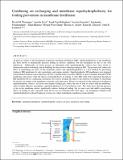Combining air recharging and membrane superhydrophobicity for fouling prevention in membrane distillation
Author(s)
Kharraz, Jehad; Arafat, Hassan A.; Warsinger, David Elan Martin; Servi, Amelia T; Van Belleghem, Sarah M.; Gonzalez, Jocelyn V.; Swaminathan, Jaichander; Chung, Hyung Won; Gleason, Karen K; Lienhard, John H; ... Show more Show less
DownloadAir Recharging MD for Fouling Prevention -v100 preprint.pdf (1.630Mb)
OPEN_ACCESS_POLICY
Open Access Policy
Creative Commons Attribution-Noncommercial-Share Alike
Terms of use
Metadata
Show full item recordAbstract
In previous studies of the desalination technology membrane distillation (MD), superhydrophobicity of the membrane has been shown to dramatically decrease fouling in adverse conditions, but the mechanism for this is not well understood. Additionally, air layers present on submerged solid superhydrophobic surfaces have been shown to dramatically reduce biofouling, and air-bubbling has been used to reducing fouling and increase flux and efficiency in MD. The present work studies the effect of maintaining air layers on the membrane surface and superhydrophobicity as a new method for preventing fouling of MD membranes by salts, particulates, and organic particles. Superhydrophobic MD membranes were prepared using initiated chemical vapor deposition (iCVD) of perfluorodecyl acrylate (PFDA) on poly(vinyldene fluoride) PVDF membranes and used to study the effects of surface energy on fouling. A static MD setup with evaporation through an MD membrane but no condensing of permeate was used to examine the effect of air exposure on fouling, by measuring the increase in weight of the membrane caused by scale deposition. Theory was derived for the reduction of fouling on superhydrophobic surfaces, and a review of related theory was included. Air layers may displace fouling gels, reduce the area of feed in contact with the membrane, reduce foulant adhesion, and enhance superhydrophobicity in a Cassie–Baxter state. The study shows that the presence of air on the membrane surface significantly reduces biological fouling, but in some cases had mildly exacerbating effects by increasing crystal formation of salts, especially when the air was not saturated with water vapor. Air recharging combined with superhydrophobicity reduced fouling in several cases where hydrophobic membranes alone did little.
Date issued
2016-01Department
Massachusetts Institute of Technology. Department of Chemical Engineering; Massachusetts Institute of Technology. Department of Mechanical Engineering; Rohsenow Kendall Heat Transfer Laboratory (Massachusetts Institute of Technology)Journal
Journal of Membrane Science
Publisher
Elsevier
Citation
Warsinger, David M., Amelia Servi, Sarah Van Belleghem, Jocelyn Gonzalez, Jaichander Swaminathan, Jehad Kharraz, Hyung Won Chung, Hassan A. Arafat, Karen K. Gleason, and John H. Lienhard V. “Combining Air Recharging and Membrane Superhydrophobicity for Fouling Prevention in Membrane Distillation.” Journal of Membrane Science 505 (May 2016): 241–252.
Version: Author's final manuscript
ISSN
03767388